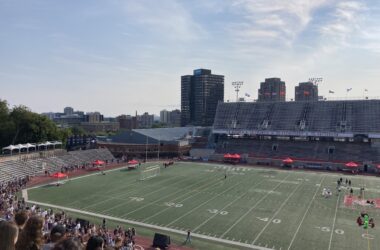On Nov. 21, the Office of Student Life and Learning (SLL) officially launched Building 21 (B21), a building dedicated to providing a place for free academic expression. The structure will serve as a space for members of the McGill community from all different backgrounds and fields to collaborate on interdisciplinary projects. Located at 651 Sherbrooke Street W, B21 boasts a virtual reality room and a large whiteboard space for planning out impromptu projects.
The building previously served as the Royal Victoria College warden’s apartment when the residence was a women-only facility before 2010. It then became the apartment for the Director of Residence at McGill, who resigned last year, making the space available.
Anita Parmar, senior advisor for Innovative Collaboration at SLL, is overseeing the initiative. She hopes B21 will become an area where students and faculty can examine educational interests that do not expressly match their chosen field of studies.
“We are trying to create a new type of space at McGill that encourages free exploration,” Parmar said. “It is very important to be guided through your educational career by experts, but if the only thing that you experience is being guided, then your ability to connect with your intuition, and to perhaps come up with new innovative and creative ideas, there is never a place to develop [those].”
Parmar believes that the project will allow the McGill community to step away from its legacy of strictly-regulated curricula.
“The underlying philosophy of Building 21 is that you come in and you explore the things [academic concepts that] you want to explore,” Parmar said. “You explore the things that you are actually curious about, so you are not hindered by whatever faculty you are in, nor are you hindered by an impending deadline. The idea is simply to explore freely and really try to understand the essence of a particular subject.”
Deputy Provost (Student of Life and Learning) Ollivier Dyens, who founded the B21 concept at McGill, credits the Massachusetts Institute of Technology (MIT)’s Building 20 (B20) as his inspiration. MIT constructed B20 as a temporary radiation laboratory during the First World War. A wide variety of intellectuals gathered in the building, producing influential work, like the writings of Noam Chomsky and the invention of radio detection and ranging (RADAR) technologies.
“To explain B21 I have to explain B20, because B21 is named after B20,” Dyens said. “We said let’s call [the project] Building 21 in homage to Building 20. And 21 for the 21st century.”
B21’s motto, “Beautiful. Beta. Beyond.” is meant to convey that the initiative is a space for exploring and cultivating beauty.
STEM Support McGill member Pauline Pestre, U4 Science, aims for her group to use the space to promote an inclusive community in the fields of science and mathematics.
“We have similar goals [to B21] in that we want to bring people together from different fields,” Pestre said. “[At B21] we’ve hosted our inaugural brunch [and] a cocktail hour to discuss our ideas for what we want to do with the group.”
Currently, B21’s mission is loosely defined, and Dyens said he hopes its description remains flexible.
“This is not a research center,” Dyens said. “It is not an accelerator. It is not an incubator. It is none of these things that exist already at McGill. [It is a place] where you go back to the original idea of the university.”








Skillz